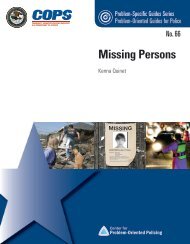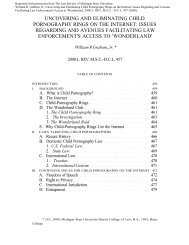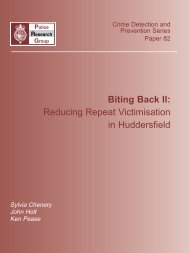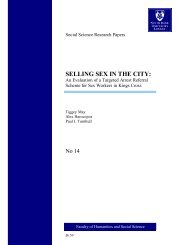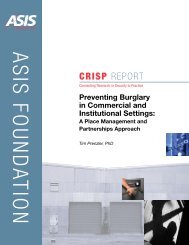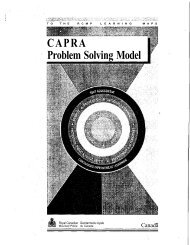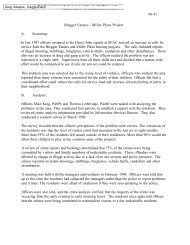Child Pornography: - Center for Problem-Oriented Policing
Child Pornography: - Center for Problem-Oriented Policing
Child Pornography: - Center for Problem-Oriented Policing
Create successful ePaper yourself
Turn your PDF publications into a flip-book with our unique Google optimized e-Paper software.
the court ruled that the requirement was sufficiently narrowly tailored and sufficiently furthered<br />
a governmental interest in abating child pornography to withstand scrutiny. 173<br />
Until 1990 federal law addressed only the production, sale, and distribution of child<br />
pornography. Under the Supreme Court's decision in Stanley v. Georgia, 174 the government<br />
could prohibit the sale and distribution of obscene material but the prohibition on private<br />
possession of such material violated the First Amendment's guarantee of "free thought and<br />
expression" and the Fourth Amendment's guarantee of privacy rights. 175<br />
In the late 1980s, however, states started passing statutes prohibiting the mere possession<br />
of child pornography. These statutes were immediately challenged under Stanley and eventually<br />
led to the 1990 Supreme Court decision in Osborne v. Ohio. 176 In Osborne the Supreme<br />
Court held that the state's interest in preventing the sexual abuse of children justified a limitation<br />
on the right to possess and view obscene materials in the privacy of a person's own home<br />
under the First Amendment as set <strong>for</strong>th in Stanley. The state could prohibit the mere possession<br />
of child pornography as long as its goal was to protect children and not to regulate<br />
people's thoughts and expressions. 177 Following the Osborne decision Congress criminalized<br />
the possession of three or more pieces of child pornography through the <strong>Child</strong> Protection<br />
Restoration and Penalties Enhancement Act of 1990. 178<br />
In 1996 Congress passed two additional pieces of legislation aimed at protecting children<br />
from computer-based exploitation. They are the <strong>Child</strong> <strong>Pornography</strong> Prevention Act (CPPA)<br />
and Communications Decency Act (CDA). Both engendered constitutional challenges.<br />
The <strong>Child</strong> <strong>Pornography</strong> Prevention Act of 1996 179 responded to the increase in technological<br />
capabilities to produce images that look like children by amending the definition of<br />
child pornography to include any visual depiction that "is, or appears-to-be, of a<br />
minor engaging in sexually explicit conduct." 180 It also banned visual depictions that are<br />
"advertised, promoted, presented, described[,] or distributed in such a manner that conveys<br />
the impression" that they contain sexually explicit depictions of minors. 181<br />
Among Congress' findings accompanying the CPPA was the recognition that new photographic<br />
and computer imaging technologies make it possible to produce visual depictions of<br />
what appear to be children engaging in sexual conduct that are virtually indistinguishable<br />
from photographic images of actual children engaging in sexually explicit conduct. Congress<br />
noted that this technology could be used to alter innocent pictures of children to create visual<br />
depictions of those children engaging in sexual conduct. 182<br />
Several cases have challenged the CPPA on constitutional grounds. In United States v.<br />
Hilton the First Circuit Court of Appeals overturned a lower court ruling that the statute was<br />
impermissibly vague and overbroad. The First Circuit found that the CPPA "neither impinges<br />
substantially on protected expression nor is so vague as to offend due process." 183<br />
More recently the Ninth Circuit Court of Appeals in The Free Speech Coalition v. Reno 184<br />
overturned a lower-court ruling upholding the CPPA and found that the provisions criminalizing<br />
all visual depictions that "appear-to-be" or "convey-the-impression" of child pornography<br />
violate First Amendment free-speech protections.<br />
At issue in The Free Speech Coalition v. Reno were the CPPA's amendments to the definition<br />
of child pornography under Title 18 of the United States Code: Section 2256(8)(B)<br />
which includes sexually explicit depictions that appear to be minors, and Section 2256(8)(D)<br />
which includes visual depictions that are "advertised, promoted, presented, described[,] or<br />
distributed in such a manner that conveys the impression" that they contain sexually explicit<br />
depictions of minors. 185<br />
14 - CHILD PORNOGRAPHY: THE CRIMINAL-JUSTICE-SYSTEM RESPONSE




